Miami’s CRE Highlights of 2021
Here are the consequential trends that have set the stage for the market this year.
The Magic City has seen a steep recovery since the onset of the pandemic in early 2020. Although Miami’s economy relies heavily on tourism and the sector is still one of the most affected by the ongoing health crisis, the city’s economy has embarked upon a fairly smooth recovery.
The unemployment rate dropped sharply since hitting a maximum of 10.3 percent in April 2020, to reach 3.7 percent in November, preliminary data from the Bureau of Labor Statistics shows. The rate is still higher than in November 2019, when it stood at 1.9 percent. Between January and November, the city has gained nearly 62,000 jobs, but is still 46,700 jobs short compared to the same month in 2019.
The fintech exodus to rapidly growing southern markets such as Austin, as well as to business-friendly South Florida metros, has attracted high-profile companies. Blackstone, Toma Bravo, Uber and Microsoft were among the heavy players that made new commitments to the Miami area during the past year.
The collapse of the Surfside condo tower left the world in shock. As rescue efforts continued, it became clear that the outcome of the event was catastrophic. The tragic occurrence shook the entire real estate sector, raising awareness about the huge responsibility the industry carries.
Here are the most significant happenings that shaped Miami’s real estate market throughout 2021 and paved the way for the years to come.
Blackstone Bets Big on Miami
In March, Blackstone made a significant commitment to the city in a record-breaking deal that was the talk of the town. The alternative asset management firm paid $230 million for 2 and 3 MiamiCentral from Shorenstein Properties, sealing the deal at $689.8 per square foot, more than double the city’s average of $305 per square foot at that point. Totaling 330,000 square feet, the newly constructed Class A buildings were 98 percent occupied at the time of the sale.
In April, Miami and Phoenix were the only two U.S. markets which recorded year-on-year growth both in transaction volume, and average price per square foot, according to CommercialEdge data.
There were two other significant sales through 2021 in the metro. The largest building that changed hands was the 1 million-square-foot One Biscayne Tower. A joint venture of CP Group, funds managed by Rialto Capital Management and Sabal Capital Partners picked up the 38-story downtown asset for $225 million.
Also in June, Monarch Alternative Capital acquired a 90 percent interest in Citigroup Center, the second largest Class A office building in the state. Townsend Group sold the 34-story, more than 800,000-square-foot tower at a total estimated value of $333.3 million.
Attracting High-Profile Firms
Throughout the year, several major leases were chalked up. In April, Chicago-based Toma Bravo signed a two-story, 36,500-square-foot lease at OKO Group and Cain International’s upcoming 830 Brickell tower, cementing the private equity firm’s presence on the East Coast. Long-anticipated, the 55-story downtown skyscraper represents Miami’s first significant office high-rise in more than a decade and is on the right track for delivery by the end of 2022.
Later in the year, Microsoft also inked a 50,000-square-foot lease at 830 Brickell. The new premises will house the tech giant’s Latin America regional team.
During the summer, New York City-based hedge fund D1 Capital Partners committed to 25,000 square feet at Related Group’s recently completed 2850 Tigertail Ave. in Coconut Grove, adding to the list of Wall Street firms that opened offices recently in South Florida. The newly constructed building is also home to the developer’s corporate headquarters.
“We’ve been preparing for this type of influx for many years now. […] It was only a matter of time before firms based in the Northeast, and other regions, decided to make the move,” Nicholas Pérez, vice president of Related and the project’s lead developer, told Commercial Property Executive.
Surfside Condo Tower Collapses
On June 24, the 12-story Champlain Tower South in Surfside, Fla. partially collapsed, resulting in the deaths of 98 people. One of the deadliest structural engineering failures in U.S. history, the tragic incident raised awareness about the importance of building maintenance, as serious structural problems had been previously reported.
Three years earlier, structural issues in the construction of the pool deck were discovered. Specifically, the waterproofing layer was not sloped, leading to the gradual deterioration of the concrete slab below. In addition to this issue, a maintenance manager reported a possible saltwater ingress, which could have also damaged the slab.
Kurt George, vice president of marketing and strategy for Texas-based Property Damage Appraisers, told Multi-Housing News: “The important lesson to take from this tragedy is that when structural red flags are raised, immediate action is prudent to save lives and avoid catastrophic outcomes.”
In a sign of respect for the victims and their families, the annual Fire on the Fourth festival was canceled by the City of Miami Beach, as well as other Independence Day events in metro Miami. The investigation is ongoing.
Active development pipeline
Although other gateway markets have been shrinking their development pipeline due to uncertainties surrounding the pandemic, Miami’s construction activity has not been suppressed.
In November, a $500 million mixed-use project dubbed Transit Village received funding from a joint venture of Related Group, BH Group and Globe Invest Ltd.—the investment arm of billionaire London-based Israeli businessman Teddy Sagi. The 10-acre development in Palm Beach obtained approval for 1.5 million square feet of flexible zoning uses, including some 300,000 square feet of office space, 3,500 square feet of community space and 24,000 square feet of retail.
At the end of 2021, New York-based R&B Realty Group’s first office building in South Florida, dubbed The Gateway at Wynwood, received a temporary certificate of occupancy. Biotech company Very Inc. has signed a lease at the property and will relocate its headquarters to the 13-story, 220,900-square-foot building.
Looking toward the future
In 2022, a number of highly anticipated projects are slated to begin construction. Set to become the tallest building south of New York City, Waldorf Astoria Residences Miami is planned to reach 1,049 feet and 100 stories. Set to rise in Brickell, the project will comprise 360 condos and 205 hotel keys, representing the luxury hotel brand’s first location in the city.
Magic City Innovation District–Little Haiti is another large-scale development that is expected to break ground in 2022. Developed by Plaza Equity Partners, Metro 1 and Lune Rouge, the $1 billion project will span 18 acres in one of Miami’s most culturally rich neighborhoods.

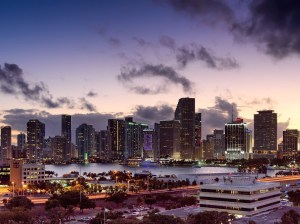
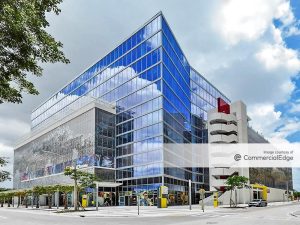
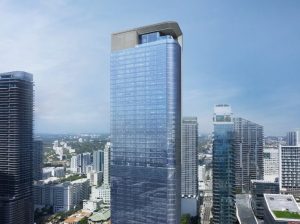
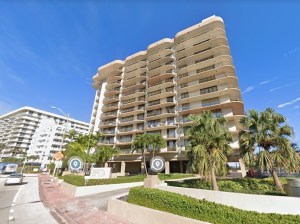
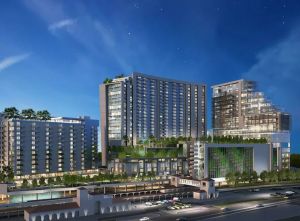






You must be logged in to post a comment.